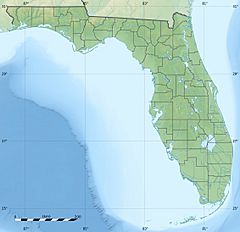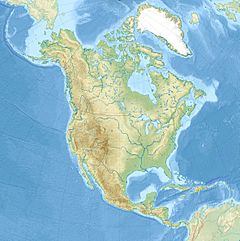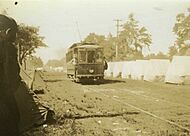Pensacola, Florida facts for kids
Quick facts for kids
Pensacola
|
||
|---|---|---|
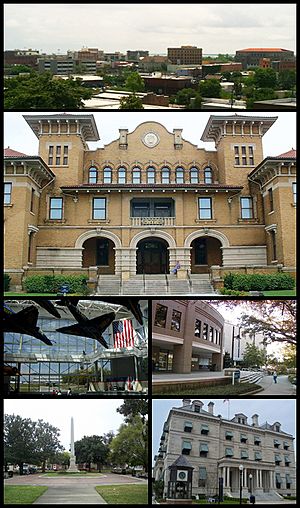
Clockwise from top: Pensacola skyline, Pensacola Museum of History, University of West Florida Library, Escambia County Courthouse, William Dudley Chipley Obelisk, National Naval Aviation Museum
|
||
|
||
| Motto(s):
"Florida's First & Future"
|
||
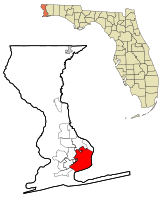
Location in Escambia County and the state of Florida
|
||
| Country | United States | |
| State | Florida | |
| County | Escambia | |
| First settled | 1559 | |
| Resettled | 1667 | |
| Incorporated | 1822 | |
| Founded by | Don Tristan de Luna | |
| Government | ||
| • Type | Mayor–Council | |
| • Body | Pensacola City Council | |
| Area | ||
| • City | 41.12 sq mi (106.49 km2) | |
| • Land | 22.76 sq mi (58.95 km2) | |
| • Water | 18.36 sq mi (47.54 km2) | |
| • Metro | 1,669.30 sq mi (4,323.5 km2) | |
| Elevation | 102 ft (31 m) | |
| Population
(2020)
|
||
| • City | 54,312 | |
| • Density | 2,386.19/sq mi (921.30/km2) | |
| • Urban | 390,172 (US: 108th) | |
| • Urban density | 1,486.2/sq mi (573.8/km2) | |
| • Metro | 509,905 (US: 110th) | |
| • Metro density | 1,669.30/sq mi (644.52/km2) | |
| Demonym(s) | Pensacolian | |
| Time zone | UTC−6 (CST) | |
| • Summer (DST) | UTC−5 (CDT) | |
| ZIP codes |
32501-32509,
32511-32514, 32516, 32520-32524, 32526, 32534, 32559, 32573-32576, 32581, 32582, 32589-32598 |
|
| Area code(s) | 850, 448 | |
| FIPS code | 12-55925 | |
| GNIS feature ID | 0294117 | |
Pensacola is a city located in the Florida Panhandle in the United States. It is the main city of the Pensacola Metropolitan Statistical Area, which had over 500,000 residents in 2020. Pensacola was the first place in the United States where Europeans tried to settle, back in 1559.
Pensacola was first settled by the Spanish Empire in 1559. However, a big hurricane caused the settlement to be abandoned. It was not re-established until 1698. Pensacola is a seaport on Pensacola Bay, which is protected by Santa Rosa Island. This bay connects to the Gulf of Mexico.
A large United States Naval Air Station is located in Pensacola. It was the first one in the United States. This base is home to the famous Blue Angels flight demonstration team and the National Naval Aviation Museum. The University of West Florida is also located north of the city center.
The area was originally home to Muskogean-speaking people. The Pensacola people lived there when Europeans first arrived. Creek people from nearby areas often visited to trade. Spanish explorer Tristán de Luna started a settlement in 1559, but it didn't last long. In 1698, the Spanish built a fort, and the modern city slowly grew from there. The area changed hands many times as different European powers fought for control in North America.
Pensacola is known as "The City of Five Flags." This is because five different governments have ruled it: Spain, France, Great Britain, the United States, and the Confederate States of America. Other nicknames include "World's Whitest Beaches," "Cradle of Naval Aviation," and "America's First Settlement."
Contents
A Look Back in Time
![]() Spanish Empire 1559–1719, 1722–1763 and 1781–1821
Spanish Empire 1559–1719, 1722–1763 and 1781–1821
![]() French Empire 1719–1722
French Empire 1719–1722
![]() British Empire 1763–1781
British Empire 1763–1781
![]() United States 1821–1861
United States 1821–1861
![]() Confederate States of America 1861–1865
Confederate States of America 1861–1865
![]() United States 1865 to present
United States 1865 to present
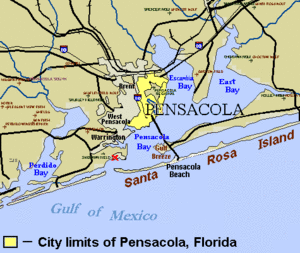
Early Native Americans
The first people to live in the Pensacola Bay area were Native American tribes. When Europeans arrived, a tribe called the Pensacola people lived there. This tribe gave the bay and the city its name. Creek people from southern Alabama also visited often to trade.
A well-known Native American site is Bottle Creek, located west of Pensacola. It has 18 large earth mounds, with five around a central plaza. This site was important for ceremonies and trade from 1250 CE to 1550. People traveled easily by dugout canoe to this site.
Spanish Explorers Arrive
The written history of Pensacola began in the 1500s. Spanish explorers were the first Europeans to reach the area. Expeditions by Pánfilo de Narváez in 1528 and Hernando de Soto in 1539 both visited Pensacola Bay.
In the age of sailing ships, Pensacola was a very busy port on the Gulf of Mexico. It had the deepest harbor, which was great for ships.
On August 15, 1559, Tristán de Luna y Arellano arrived with about 1,500 people on 11 ships from Mexico. They wanted to set up an outpost called Santa María de Ochuse. But a huge hurricane hit on September 19, 1559. It sank six ships, damaged another, and ruined supplies.
The survivors struggled to live. Many moved inland for months before returning to the coast. In 1561, the settlement was given up. The Spanish decided northwest Florida was too dangerous to settle and left it alone for 137 years.
In the late 1600s, the French began exploring the Mississippi River. They wanted to claim the area as part of New France. To protect their territory, the Spanish started a new settlement in western Florida. In 1698, they built a fortified town near what is now Fort Barrancas. This was the beginning of the modern city of Pensacola.
The Spanish built three forts in Pensacola:
- Presidio Santa Maria de Galve (1698–1719): This fort included San Carlos de Austria and a village.
- Presidio Isla de Santa Rosa (1722–1752): This fort was on western Santa Rosa Island. Hurricanes damaged it, so the soldiers moved to the mainland.
- Presidio San Miguel de Panzacola (1754–1763): This final fort was built about 5 miles east of the first one. The historic downtown area of Pensacola grew around this fort.
During these early years, a mixed society developed. Spanish soldiers often married or had families with Native American or African women. This created a population of mestizos (mixed Spanish and Native American) and mulattos (mixed Spanish and African). The Spanish also offered freedom to enslaved people who escaped from other colonies if they converted to Catholicism.
British Rule

After many years, Spain gave Florida to the British in 1763. This happened after Britain won the French and Indian War. The British made Pensacola the capital of their new colony, British West Florida. They made the forts stronger, building the Royal Navy Redoubt.
During the American Revolutionary War, most colonists in West Florida stayed loyal to the British. In 1779, Spain joined the war against Britain. Spanish forces captured Pensacola in the 1781 Siege of Pensacola. After the war, the British officially gave Florida back to Spain.
In 1785, many Creek people came to Pensacola to trade. The city became a major trading hub. Americans started raiding the area, and settlers wanted the U.S. government to take control.
Becoming Part of the United States
In 1814, during the War of 1812, American troops attacked Pensacola. The Spanish and British forces defending the city surrendered. Pensacola was taken again by the U.S. in 1818. In 1819, Spain and the United States signed a treaty. Spain gave Florida to the U.S. in exchange for the U.S. recognizing Spanish control over Texas.
In 1821, Pensacola became part of the United States, with Andrew Jackson as governor. The city officially became a municipality in 1822. Many people in Pensacola were of mixed French, Spanish, and Native American heritage. However, as more white Americans moved in, racial divisions became stricter.
During the American Civil War, Pensacola saw fighting. In 1861, Confederate forces lost the nearby Battle of Santa Rosa Island. After New Orleans fell in 1862, the Confederacy left Pensacola, and the Union army occupied it.
In 1908, a citywide streetcar strike happened. This led to state soldiers being sent to the city, and martial law was declared.
Pensacola's Location and Climate
Pensacola is on the north side of Pensacola Bay. It is about 59 miles east of Mobile, Alabama, and 196 miles west of Tallahassee, Florida's capital. Many communities just outside Pensacola's city limits are also considered part of Pensacola.
The city's land slopes up from Pensacola Bay. Most of the city is high enough to be safe from potential hurricane storm surges. Pensacola has a humid subtropical climate. This means it has short, mild winters and hot, humid summers.
Weather and Storms
Summer temperatures are usually in the low 90s°F (32–34°C). Thunderstorms are common in the afternoons or evenings during summer. Temperatures above 100°F (38°C) are rare. The highest temperature ever recorded was 106°F (41°C) on July 14, 1980.
In winter, freezing temperatures happen about 11 days a year. The average first freeze is December 12, and the last is February 14. Snow is rare but does fall sometimes. The city gets about 68 inches of rain each year, with more rain in the summer.

Pensacola's location on the Florida Panhandle makes it likely to be hit by hurricanes. Major hurricanes that have hit or come close include Eloise (1975), Frederic (1979), Ivan (2004), and Sally (2020).
Hurricane Ivan's Impact
On September 16, 2004, Hurricane Ivan caused a lot of damage to Pensacola. The storm surge destroyed most of the I-10 Escambia Bay Bridge. It also destroyed the fishing bridge next to the Phillip Beale Memorial Bridge.
Ivan caused over $6 billion in damage in the area. More than 10,000 homes were destroyed, and 27,000 more were heavily damaged.
Hurricane Sally's Impact
In September 2020, Hurricane Sally also caused heavy damage. Downtown Pensacola was flooded. Local officials estimated damages in Escambia County at $29 million.
Pensacola's People
Pensacola first appeared in the U.S. Census in 1850 with 2,164 people. In 1860, it was Florida's largest city with 2,876 people.
| Race / Ethnicity (NH = Non-Hispanic) | Pop 2010 | Pop 2020 | % 2010 | % 2020 |
|---|---|---|---|---|
| White (NH) | 33,383 | 35,105 | 64.29% | 64.64% |
| Black or African American (NH) | 14,420 | 12,054 | 27.77% | 22.19% |
| Native American or Alaska Native (NH) | 269 | 194 | 0.52% | 0.36% |
| Asian (NH) | 1,024 | 1,290 | 1.97% | 2.38% |
| Pacific Islander or Native Hawaiian (NH) | 62 | 43 | 0.12% | 0.08% |
| Some other race (NH) | 58 | 269 | 0.11% | 0.50% |
| Mixed race or Multiracial (NH) | 996 | 2,519 | 1.92% | 4.64% |
| Hispanic or Latino (any race) | 1,711 | 2,838 | 3.30% | 5.23% |
| Total | 51,923 | 54,312 | 100.00% | 100.00% |
In 2020, there were 54,312 people living in Pensacola. The Pensacola metropolitan area had 509,905 people.
Economy and Tourism
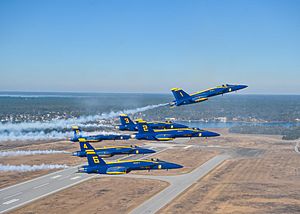
Military Presence
Pensacola is known as "The Cradle of Naval Aviation." Naval Air Station Pensacola (NASP) was the first U.S. Navy air station, opened in 1914. Many naval aviators, including John H. Glenn and Neil Armstrong, trained there. The Navy's famous Blue Angels flight team is based here.
The National Museum of Naval Aviation is located at the Naval Air Station. It's free to visit and has hundreds of old Naval Aviation aircraft. It also shares the history of naval flight through displays and movies.
Fun Things to Do
Pensacola hosts many yearly festivals and events. The Pensacola Seafood Festival and the Pensacola Crawfish Festival have been held for almost 30 years. The Great Gulfcoast Arts Festival happens every November, showing art from over 200 artists. The Children's Art Festival displays art by local students. Pensacon is a comic convention in February that draws nearly 25,000 visitors. The Pensacola Interstate Fair is held every fall.
Scuba diving and deep sea fishing are popular activities. The USS Oriskany was sunk on purpose in 2004 to create an artificial reef for divers.
You can also take walking tours of Pensacola's old neighborhoods from the 1700s. Pensacola has the Vietnam Veterans' Wall South. There are also historic military forts from the American Civil War, like Fort Barrancas. Fort Pickens was even a temporary prison for Geronimo. Other military sites include the National Naval Aviation Museum and Pensacola Lighthouse.
Top Employers
Pensacola has many important employers. Here are some of the largest:
| Rank | Employer | Employees |
|---|---|---|
| 1 | Navy Federal Credit Union | 7,723 |
| 2 | Baptist Health Care | 6,633 |
| 3 | Sacred Heart Health Systems | 4,820 |
| 4 | Florida Power And Light | 1,774 |
| 5 | West Florida Healthcare | 1,200 |
| 6 | Ascend Performance Materials | 888 |
| 7 | Alorica (fka West Corporation) | 800 |
| 8 | Innisfree Hotels | 750 |
| 9 | Santa Rosa Medical Center | 521 |
| 10 | Medical Center Clinic | 500 |
Arts and Culture
The Arts and Theatre
Pensacola has many places for performances. The Pensacola Bay Center hosts big events. The Saenger Theater is used for plays and concerts. Other places for live shows include the Pensacola Little Theatre and the Vinyl Music Hall.
Pensacola is also home to the Pensacola Opera, Pensacola Children's Chorus, and Pensacola Symphony Orchestra. There is also Ballet Pensacola. The Palafox Place area is a popular spot for entertainment.
Buildings and Architecture
Pensacola doesn't have many very tall skyscrapers. The tallest building is the 15-floor Crowne Plaza Grand Hotel. Other tall buildings include the Scenic Apartments and the SunTrust Tower.
Historic buildings include the First National Bank Building.
Museums to Explore
Pensacola has several interesting museums:
- Historic Pensacola's Museum of Commerce
- Museum of Industry
- National Naval Aviation Museum
- Pensacola MESS Hall (a science museum)
- Pensacola Museum of Art
Pelican Drop Celebration
The Pelican Drop was a New Year's Eve celebration in downtown Pensacola. Instead of a ball, an aluminum pelican was dropped to mark the new year. The event included live music and fireworks.
From 2008 to 2018, the Pelican Drop was a big attraction. It drew up to 50,000 people and was one of the largest New Year's events in the Central Time Zone. In 2014, it was named one of the Top 20 Events in the Southeast.
The first Pelican Drop was in 2008. In December 2019, organizers announced the event was canceled. This was due to money issues and the burden it placed on local police and public services. A smaller fireworks show is now held instead.
The pelican was made of shiny aluminum and had over 2,000 lights. It had a 17-foot wingspan and was 12 feet high.
Sports and Recreation
Pensacola has several sports teams:
| Team | Sport | League | Venue |
| Pensacola Ice Flyers | Ice hockey | SPHL | Pensacola Bay Center |
| Gulf Coast Riptide | American football | Women's Spring Football League | Escambia High School |
| Pensacola Blue Wahoos | Baseball | Southern League (AA) | Pensacola Bayfront Stadium |
| Pensacola Christian Eagles | Basketball, Soccer, Volleyball | NCCAA Division II South Region | Arlin R. Horton Sports Center (basketball/volleyball) Eagle Field (soccer) |
| Pensacola FC | Soccer | Gulf Coast Premier League | Ashton Brosnaham Stadium |
| West Florida Argonauts | Baseball, Basketball, XC, American Football, Golf, Soccer, Softball, Swimming, Tennis, Volleyball | NCAA Division II Gulf South Conference | Jim Spooner Field (baseball) Pen Air Field (football) UWF Field House (basketball/volleyball) UWF Soccer Complex (soccer) UWF Softball Complex (softball) |
| Pensacola Roller Gurlz | Flat Track Roller Derby | Women's Flat Track Derby Association | Dreamland Skate Center |
The Five Flags Speedway is a half-mile racetrack that opened in 1953. It hosts the Snowball Derby stock car race every December.
Parks and Outdoor Fun
Pensacola has many parks and natural areas:
- Gulf Islands National Seashore
- Big Lagoon State Park - about 10 miles southwest of Pensacola.
- Perdido Key State Park - on a barrier island 15 miles southwest of Pensacola.
- Tarkiln Bayou Preserve State Park - 10 miles southwest of Pensacola.
- Pensacola Bayfront Stadium - a multi-use park.
- Plaza Ferdinand VII
- Bayview Park
- Miraflores Park
Education in Pensacola
The main campus of Pensacola State College is in the city. The University of West Florida (UWF) has a campus downtown. Its main campus, north of the city, has the largest library in the region. UWF is the biggest college in the area.
Public schools are managed by the Escambia County School District. The district has two high schools in Pensacola: Booker T. Washington and Pensacola. Other public schools include A.K. Suter Elementary and J.H. Workman Middle.
Several private schools are also in or near the city. These include Pensacola Catholic High School and Pensacola Christian Academy. The campus of Pensacola Christian College is also nearby.
Media and News
The largest daily newspaper is the Pensacola News Journal. There is also an alternative weekly newspaper called Inweekly.
Pensacola has several TV stations. WEAR-TV is the ABC channel. WSRE-TV is the local PBS station, run by Pensacola State College. Other TV channels are located in Mobile, Alabama. WUWF is the local NPR radio station.
Pensacola Magazine is a monthly magazine about the city. Northwest Florida's Business Climate is a business magazine for the region.
Getting Around Pensacola
Air Travel
Major air travel for Pensacola is handled by Pensacola International Airport. Airlines serving the airport include American Airlines, Delta Air Lines, Southwest Airlines, and United Airlines.
Trains
Pensacola was first connected by rail to Montgomery, Alabama, in 1861. During the Civil War, much of the track was removed. It was rebuilt in 1868. In 1882, the Pensacola and Atlantic Railroad connected Pensacola to the rest of Florida.
Passenger train service to Pensacola ended in 1971. From 1993 to 2005, Amtrak served Pensacola, but service stopped after Hurricane Katrina damaged the tracks. Today, Pensacola does not have passenger train service.
Roads
Major highways in Pensacola include:
 Interstate 10
Interstate 10 Interstate 110
Interstate 110 U.S. Route 29
U.S. Route 29 U.S. Route 90
U.S. Route 90 U.S. Route 98
U.S. Route 98
Public Transportation
The local bus service is called Escambia County Area Transit (ECAT). ECAT runs bus routes and a seasonal trolley to Pensacola Beach. There is a website and an app called Moovit to help you find bus times.
Pensacola also has a ferry service run by the National Park Service. It stops in Downtown Pensacola, Pensacola Beach, and Fort Pickens.
Hospitals
Hospitals in Pensacola include Ascension Sacred Heart Hospital, Baptist Hospital, and HCA Florida West Hospital.
Famous People from Pensacola
Many notable people have come from Pensacola.
Bands from Pensacola
- Finite Automata, an industrial music band
- This Bike is a Pipe Bomb, a folk-punk band
- Twothirtyeight, an indie rock band
- Body Head Bangerz, a hip hop group
- McAlyster, a country music group
Sister Cities
Pensacola has several sister cities around the world:
 Chimbote, Peru
Chimbote, Peru Escazú, Costa Rica
Escazú, Costa Rica Gero, Japan
Gero, Japan Isla Mujeres, Mexico
Isla Mujeres, Mexico Horlivka, Ukraine
Horlivka, Ukraine Miraflores, Peru
Miraflores, Peru Kaohsiung, Taiwan
Kaohsiung, Taiwan Macharaviaya, Spain
Macharaviaya, Spain
See also
 In Spanish: Pensacola para niños
In Spanish: Pensacola para niños



